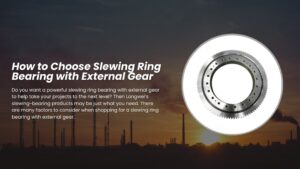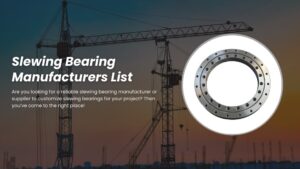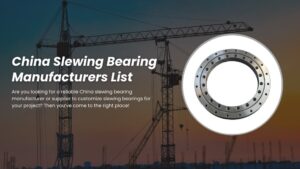Table of Contents
Introduction to Slewing Bearings
Slewing bearings, also known as slewing rings or slew bearings, are a special type of rolling bearings designed to support axial, radial, and moment loads simultaneously. It enables the rotation of structures such as cranes, excavators, or wind turbines by providing a low-friction connection between stationary and rotating parts.
Slewing bearings consist of two rings (inner and outer) with rolling elements (balls or rollers) that promote smooth rotation. The design allows the transmission of axial and radial loads as well as moments, which are torsional forces due to applied torque. This makes slewing bearings a critical component in machinery that requires controlled and stable rotation, especially where heavy loads and precise positioning are involved.
Slewing Bearing Production Process Steps
A myriad of intricate production processes, spanning from the initial stages with raw materials to the finalization of the products, define the manufacturing journey of slewing bearings. At every juncture of this intricate process, rigorous inspection procedures are meticulously implemented to ensure the utmost quality and precision in the end results. Longwei steadfastly adheres to a commitment aimed at crafting slewing bearings characterized by not only high precision but also exceptional reliability.
Step 1: Steel Raw Material Cutting
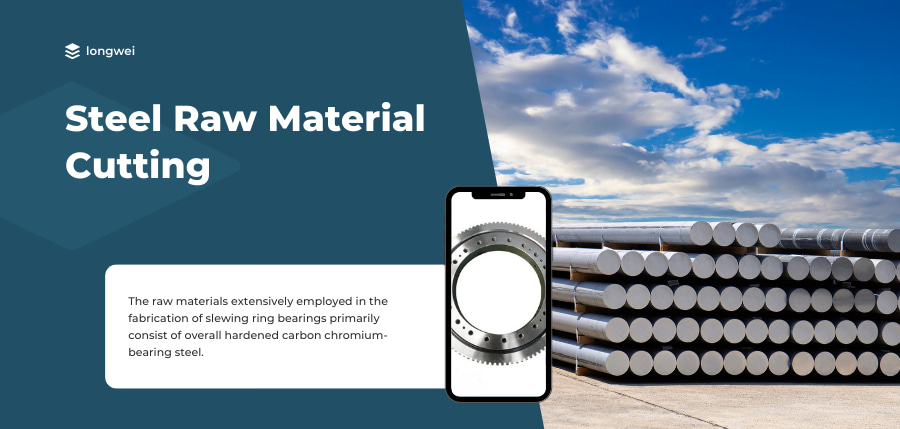
The raw materials extensively employed in the fabrication of slewing ring bearings primarily consist of overall hardened carbon chromium-bearing steel. Specifically, the slewing rings are crafted from surface-hardened steel, with 50Mn steel being a prevalent choice, exemplified by materials such as S48C, 42CrMo, and 5CrMnMo. The initial stage involves the utilization of cylindrical raw material billets, which are transported from the steel factory. These billets undergo precision cutting, tailored to the specific size requirements for the subsequent slewing ring processing.
These carbide saw blades exhibit a series of outstanding performances, contributing significantly to the seamless and high-precision preparation of raw materials for the production of slewing ring bearings.
Step 2: Billet forging

Within the confines of the heating furnace, the steel billet undergoes a transformative process wherein it is meticulously heated and skillfully forged into a distinctive round cake shape. This forging phase assumes paramount significance, serving as a crucial juncture in guaranteeing the overall reliability and extended service life of the resultant bearing. Post-forging, the raw material undergoes a metamorphosis, culminating in the formation of the bearing ring blank.
This forging operation not only shapes the bearing ring but also contributes to enhancing the overall structural integrity of the raw material. The organizational structure of the initial raw material undergoes a refinement process, leading to increased density and streamlining. This transformation, in turn, serves to elevate the reliability and longevity of the eventual slewing ring .
The quality of the forging process emerges as a critical determinant, directly influencing the utilization efficiency of raw materials. As a consequence, the intricacies of the forging process play a pivotal role in shaping not only the slewing ring bearing’s performance but also impacting the production cost through its influence on raw material utilization rates.
Step 3: Forging Ring

The billet, having undergone preliminary heating, is subjected to the precision of a ring rolling machine, where it is expertly forged into a distinctive ring-shaped steel configuration. This specialized forging process serves as a transformative step, introducing enhancements to the internal structure of the steel. Through this forging technique, the steel’s mechanical properties undergo significant improvement, manifesting in heightened strength, increased plasticity, enhanced impact toughness, and various other mechanical attributes.
Step 4: Rough Turning

Once the steel ring is positioned within the machine tool, the machining journey commences with the rough turning process. This initial phase involves the precision turning of various grooves and raceways into the steel ring, contributing to the intricate design and functionality of the component. Subsequently, the steel ring is securely affixed onto the gear milling machine, where teeth are meticulously cut out.
The primary objective underlying these machining steps is to ensure that the finished ferrule attains an identical shape to the envisaged final product. This precision in shaping and detailing is imperative, laying the groundwork for the subsequent stages of the grinding machine processing.
Step 5: Quenching (heat treatment)
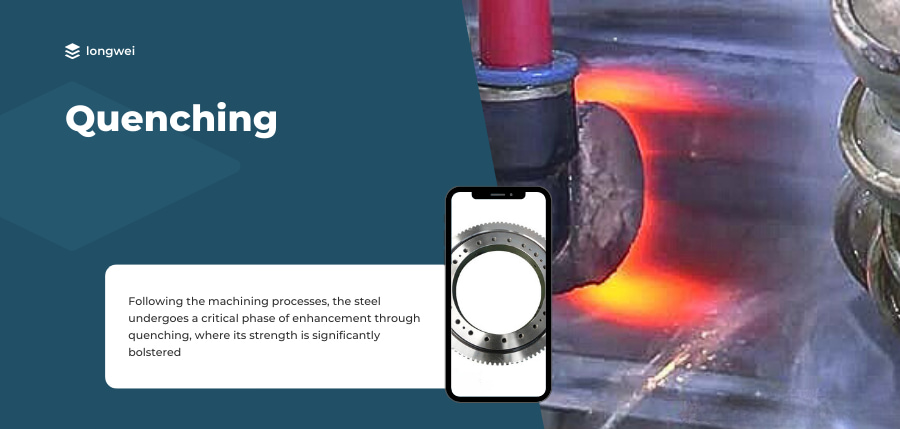
Following the machining processes, the steel undergoes a critical phase of enhancement through quenching, where its strength is significantly bolstered. This heat treatment method not only elevates the hardness of the steel but also imparts improved wear resistance, heightened fatigue strength, and enhanced toughness to the metal.
The quenching process stands as a pivotal link in the manufacturing chain, playing a crucial role in augmenting the overall performance and durability of the bearing.
The heat treatment phase involves subjecting the bearing ring, post-forging and turning, to high-temperature treatment. This step directly influences the uniformity of carburization within the bearing ring, thereby enhancing both wear resistance and hardness.
Beyond the mechanical attributes, the heat treatment process bears a profound impact on the reliability and lifespan of the bearing, positioning it as an indispensable component in ensuring the optimal functioning and longevity of the final product.
Step 6: Hole Processing
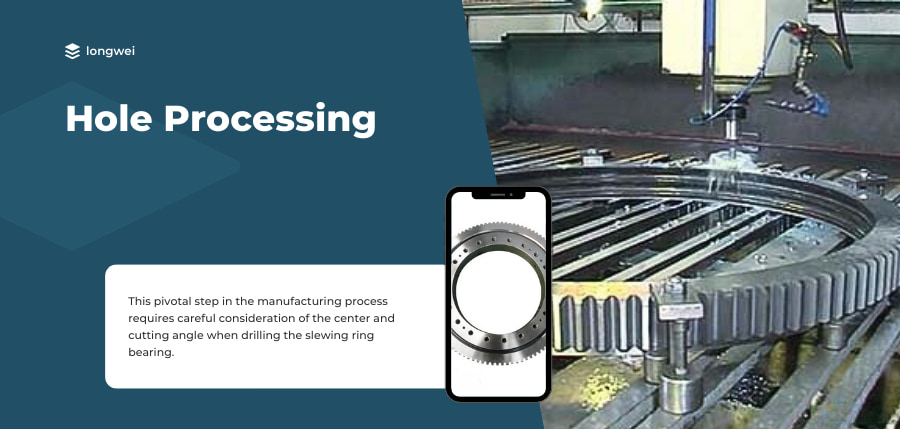
To facilitate installation, precision drilling of the installation hole is conducted on the end face of the steel ring. This pivotal step in the manufacturing process requires careful consideration of the center and cutting angle when drilling the slewing ring bearing. The choice of drilling equipment is also of utmost importance, with options ranging from specialized drilling machines to versatile hand-held electric drills and traditional hand drills, each selected based on specific operational requirements.
When drilling the slewing ring bearing, meticulous attention is paid to determining the optimal center and cutting angle. This precision ensures the creation of an installation hole that aligns seamlessly with the slewing ring bearing’s specifications. The versatility of using drilling machines, hand-held electric drills, or hand drills allows for adaptability to various manufacturing scenarios, ensuring the drilling operation is executed with the required precision and efficiency.
Step 7: Fine Grinding
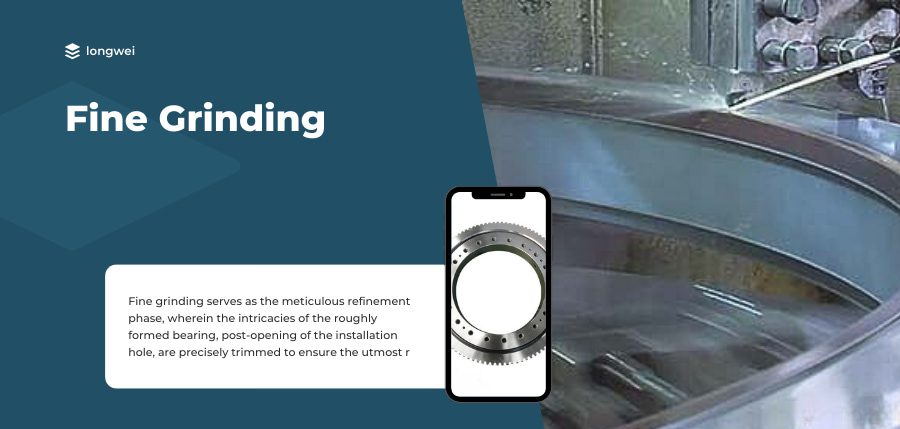
Fine grinding serves as the meticulous refinement phase, wherein the intricacies of the roughly formed bearing, post-opening of the installation hole, are precisely trimmed to ensure the utmost refinement of its appearance. This critical step in the manufacturing process plays a pivotal role in influencing the rotation flexibility of the bearing and enhancing the machining accuracy of its surface.
The impact of fine grinding extends beyond cosmetic considerations, delving into the intricate details of the slewing ring bearing’s mechanical attributes. This process is instrumental in mitigating any deformations that may have arisen from earlier manufacturing stages. By honing the bearing’s finer details through precise grinding, the rotation flexibility is optimized, contributing to the overall performance and functionality of the slewing ring.
Step 8: Assembly Work

Assemble the meticulously processed components, encompassing the outer ring, inner ring, roller, and cage, which have undergone a series of intricate manufacturing procedures. These processes include the precise insertion of steel balls, the incorporation of isolating blocks, and the addition of butter sealing strips. The objective is to meticulously craft a set of finalized slewing ring tailored to specific technical and precision requirements.
Customized Slewing Bearing Services
Longwei works with customers to customize slewing bearings for different projects. Request a quote to get more information on how our custom services can meet your project requirements.


